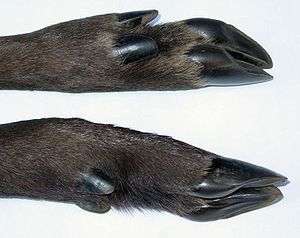Cloven hoof

A cloven hoof, cleft hoof, divided hoof or split hoof is a hoof split into two toes. This is found on members of the mammalian order Artiodactyla. Examples of mammals that possess this type of hoof are cattle, deer, antelopes, gazelles, goats, and sheep.[1] In folklore and popular culture, a cloven hoof has long been associated with the Devil.
The two digits of cloven hoofed animals are homologous to the third and fourth fingers of the hand. They are called claws and are named for their relative location on the foot: the outer, or lateral, claw and the inner, or medial claw. The space between the two claws is called the interdigital cleft; the area of skin is called the interdigital skin. The hard outer covering of the hoof is called the hoof wall, or horn. It is a hard surface, similar to the human fingernail.[2]
The almost finger-like dexterity available to cloven hoofed mammals like mountain goats and wild sheep combined with a hard outer shell and soft and flexible inner pads provide excellent traction in their precarious habitats.[3][4][5]
Evolution
It is speculated that during the Eocene period, hoofed marsh dwellers carried their body weight mainly on two of the middle toes, which grew to equal size, becoming the Artiodactyla or even-toed hoofed animals. Prior to the close of the Eocene period the side toes of some had dwindled and practically disappeared while the basal pieces or metapodium of the pair of supporting toes became fused together, thus producing the appearance of a cloven hoof.[6]
The mammal with a cloven hoof is an even-toed ungulate of order Artiodactyla as opposed to the odd-toed ungulates of Perissidactyla, like the horse, which have one toe, or the rhinoceros, which has three toes. The five-toed ancestors of the earliest Eocene had already developed feet that suggest odd-toed and even-toed descendants to the modern viewer. Even Phenacodus, the most generalized of the early mammals, has a foot in which the central toe is somewhat larger than the others and could be placed in the division of odd toed ungulates, Perissidactyla. [7]
Kashrut
The distinction between cloven and uncloven hooves is highly relevant for dietary laws of Judaism (kashrut), as set forth in the Torah[8] and the Talmud.[9][10] Animals that both chew their cud (ruminate, i.e. regurgitate partly digested food from a specialised multi-chambered stomach back to the mouth to be chewed for a second time as part of their ordinary digestive process) and have split true cloven hooves (a hoof being hard or rubbery sole and a hard wall formed by a thick nail) are allowed (kosher, lit. "fit") for Jewish consumption. Those animals that have neither of these two characteristics, or only one of the characteristics, are considered unclean animals (treif, not fit for Jewish consumption) and Jews are forbidden to eat them.
This rule thus excludes the camel from the list of kosher animals because although the camel does ruminate, it does not possess true "hooves" – it walks on soft toes which have little more than a nail merely giving an appearance of a "hoof". Similarly, the pig, although it has cloven true hooves, does not ruminate.[11][12] Other animals such as dogs or cats exhibit neither characteristic, and are thus also forbidden for Jewish consumption.
References
- ↑ American Museum of Natural History (1892). Visitors' Guide to the Geological and Palaeontological Collections. Original from the University of Michigan. p. 59.
- ↑ Kate Hepworth, Animal Sciences Student; Dr. Michael Neary, Extension Animal Scientist; Dr. Simon Kenyon, Extension Veterinarian. (October 2004). "Hoof Anatomy, Care and Management in Livestock" (PDF). Purdue University. Retrieved 2007-12-02.
- ↑ Jackson, Brenda (1998). North American Wildlife (Revised and Updated). Readers Digest. p. 68. ISBN 0-7621-0020-6.
- ↑ Streubel, Donald (2000). "Oreamnos americanus (Mountain Goat)" (Web). Idaho Museum of Natural History. Retrieved 2007-12-02.
- ↑ Plekon, Hannah J. (April 2007). "Oreamnos americanus; General description" (Web). Davidson College. Retrieved 2007-12-03.
- ↑ British Museum (Natural History) (1906). British Museum Guides: Vertrbrates. Original from the University of Michigan. p. 28.
- ↑ Cleland, Herdman Fitzgerald (1916). Geology, Physical and Historical. Original from the University of Michigan: American book company. p. 599.
- ↑ Leviticus 11:3-8
- ↑ Shulchan Aruch, Yoreh De'ah 79
- ↑ Slifkin, Natan (March 1, 2004). "6". Shafan– The Hyrax (PDF). The Camel, the Hare, and the Hyrax: The Laws of Animals with One Kosher Sign in Light of Modern Zoology. Southfield, MI; Nanuet, NY: Zoo Torah in association with Targum/Feldheim, Distributed by Feldheim. pp. 99–125. ISBN 1-56871-312-6. Archived from the original (PDF) on February 11, 2012. Retrieved May 10, 2016. ISBN 978-1-56871-312-0.
- ↑ Glover, Alfred Kingsley (1900). Jewish Laws and Customs: Some of the Laws and Usages of the Children of the Ghetto. Original from Harvard University: W.A. Hammond. p. 157.
- ↑ Eisenberg, Ronald L. (2005). The 613 Mitzvot: A Contemporary Guide to the Commandments of Judaism. Schreiber Publishing, Incorporated. p. 251. ISBN 0-88400-303-5.